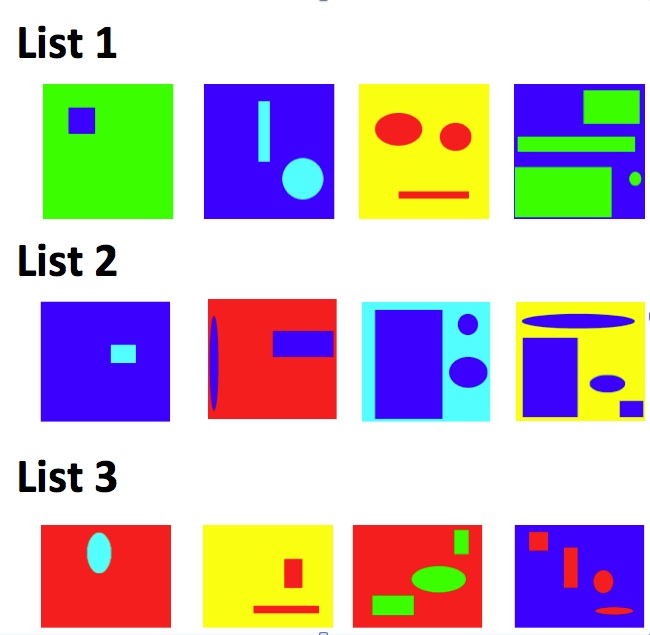Herbert S. Terrace, director
Click on any of the experiments to see a description:
|
Serially organized action, as compared to individual responses, is common in everyday behavior. It's also fundamental for the mastery of skills at all levels of complexity; as simple as knowing how to get from point A to point B and as complex as knowing how to speak and comprehend language. The primary focus of Columbia University's Primate Cognition Lab is to obtain an animal model of serially organized behavior - one that doesn't require language. Instead, it is assumed that the representation of ordinal knowledge used during the execution of these lists is spatial. To investigate the serial knowledge of a non-human primate, we train rhesus macaques to learn lists composed of arbitrarily and numerically defined list items. In each instance, those items are presented on touch sensitive video monitors. |
|
Examples of photographs used to train 4 arbitrary lists are shown in Figure 1.
As can be seen in Video 1, the task is to touch all of the items in an arbitrary order, irrespective of their physical location on the monitor. A reward (a banana pellet) is presented after the subject responds correctly to all of the items. Video 1 shows a monkey executing lists composed of the items shown in Figure 1.
Because the order in which the subject has to respond to each item is arbitrary, the sequences shown in Video 1 are reminiscent of the type of experience you would have while entering a pass code at an ATM machine or while dialing a telephone number. It is, in fact, more difficult because the configuration of the list items is varied from trial to trial to insure that you could not simply learn a rote motor sequence that would allow you to execute the sequence as a series of fixed responses. Instead, subjects have to think about (represent) their ordinal position in the sequence as they move from item to item.
|
|
A variation of the procedure for training arbitrary sequences has been used to train monkeys to learn numerical rules. In this experiment, lists were composed of geometric shapes rather than photographs. Reward was still contingent on responding to the list items in a particular order, but subjects were given an option of simplifying the problem by abstracting the numerical value of each stimulus on the basis of the number of elements they contained.
Consider, for example, the first set of stimuli shown in Figure 2. Subjects could learn that list by memorizing the items as, 1. a blue square on a green background, 2. light blue shapes on a dark blue background, 3. red shapes on a yellow background and 4. green shapes on a blue background. A simpler solution would be to encode the first stimulus as an exemplar of numerosity 1, the second as an exemplar of numerosity 2, etc. After learning more than two dozen such lists, subjects were able to respond accurately to novel lists with novel exemplars of each numerosity as, for example, when they were trained on the items shown in Lists 2 and 3. Further evidence of their knowledge of numerosity was provided by additional training in which they responded accurately to numerosities greater than four. Examples of their performance on lists containing numerosities as large as 9 items are shown on Video 2.
Video 2. Monkey responding to numerosities whose values range from 1-9. The lists executed in Videos 1 and 2 were trained by the simultaneous chaining procedure, so-called because all of the list items were displayed throughout each trial. While learning a simultaneous chain, subjects had an opportunity to compare all of the list items explicitly throughout each trial as they executed the sequence. Another procedure was used to train subjects to produce lists whose ordinal position was defined implicitly. |
|
Knowledge of implicitly defined lists was trained by the transitive inference paradigm. In this instance, a list of n items is trained by presenting only two items at a time. Subjects were required to select the "earlier" member of each pair. Earlier was defined by its position on the list when viewed explicitly. Consider, for example, the explicit list A→B→C→D→E→F→G. During transitive training, the choice of C is followed by a reward on trials on which C & D was presented while the choice of D is followed by a reward when D & E was presented. In general, the starred items of each of the following pairs was rewarded: A*C, C*D, D*E, E*F and F*G. The main evidence that subjects acquired knowledge of the explicit list A→B→C→D→E→F→G during training on a transitive inference task was their accurate performance on non-adjacent pairs that were not included during original training: BD, BE, BF, BG, CE, CF, CG, DF and DF. Performance on those pairs was essentially accurate during the first presentation of such probe trials. Pairs containing A & G were not used to evaluate knowledge of ordinal position because accurate performance on such pairs could be explained by subjects‘ history of reward. Subjects were always rewarded for selecting A on trials on which A was present and never reward for selected G on trials when G was presented. However, on the remaining non-adjacent probe trials, either item was followed by reward. In this connection, it should be noted that the same result would occur if the rule were to choose the later (as opposed to the earlier) item. Subjects would learn that list just as readily, so long as that rule was followed throughout training. Recent research has shown that the representations acquired during training on the simultaneous chaining and the transitive inference paradigms are remarkably flexible. Following the acquisition of a simultaneous chain, the same list items were used during training on a transitive inference paradigm. Transfer was immediate and virtually without error. Similar transfer to the simultaneous chaining paradigm was observed following the acquisition of a list by the transitive inference paradigm. In both instances, performance exceeded that obtained during training on control lists that used novel items. These results show that the representation of ordinal knowledge obtained during one training method is flexible enough to be used during performance on a qualitatively different method, a degree of flexibility that is all the more remarkable because it doesn't rely on language. |

